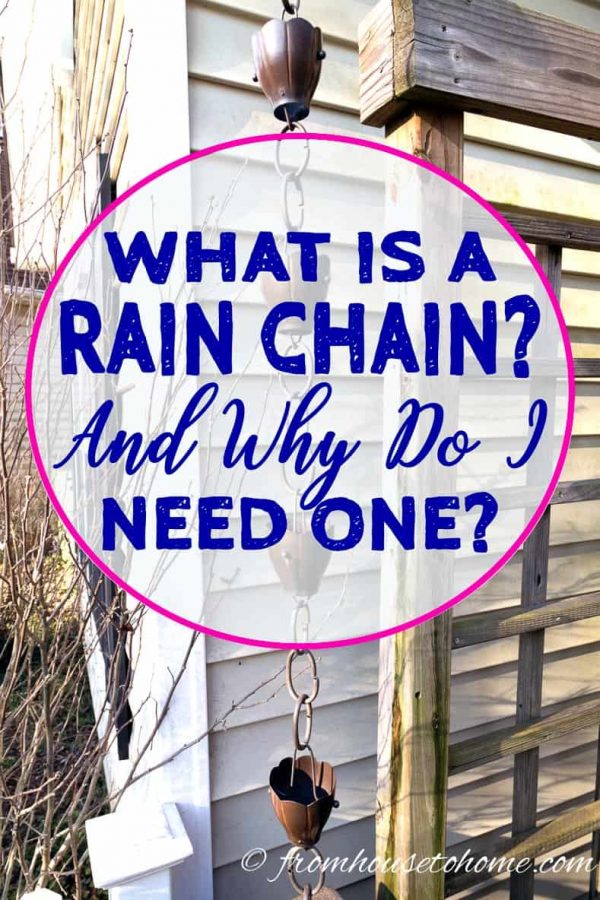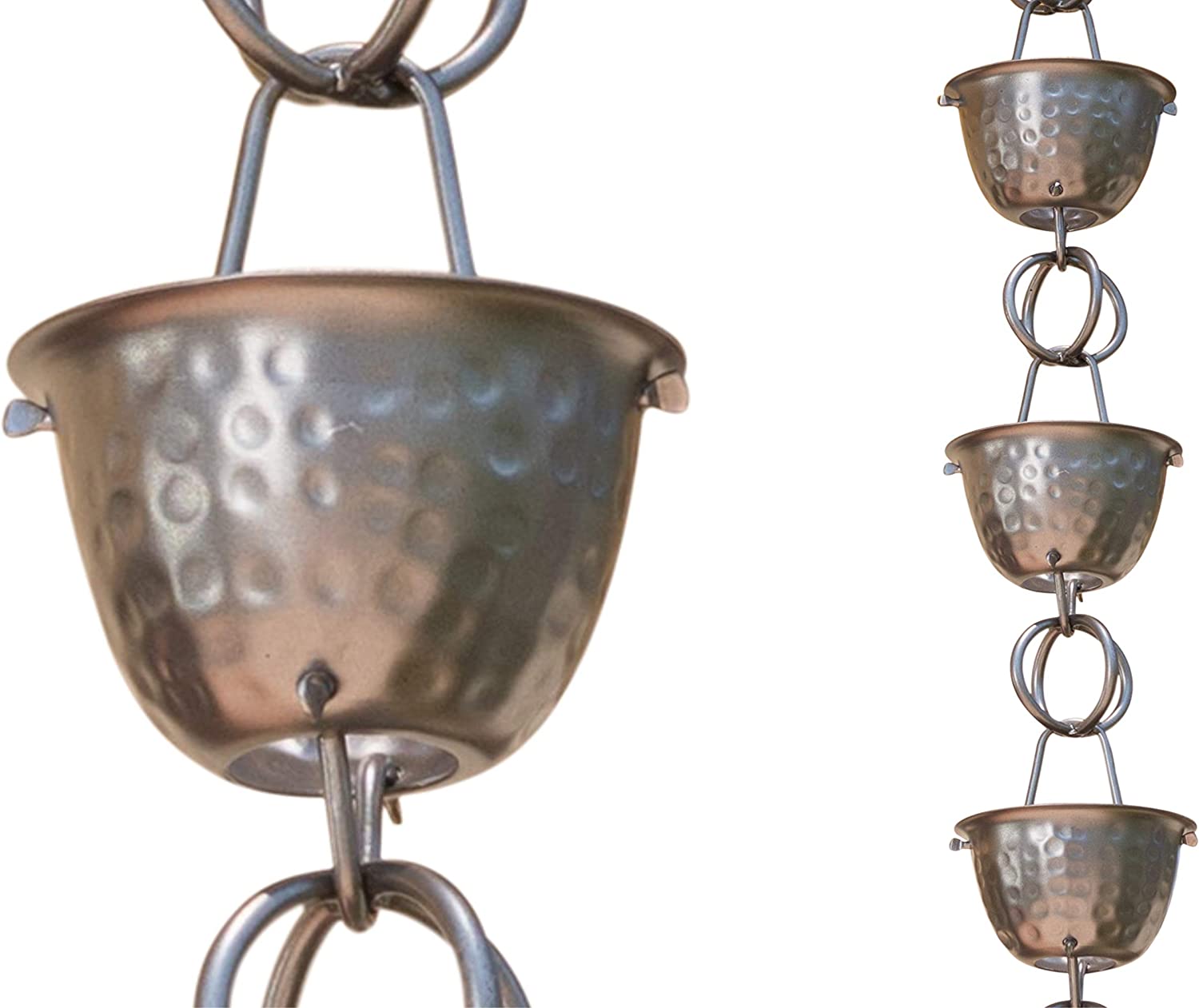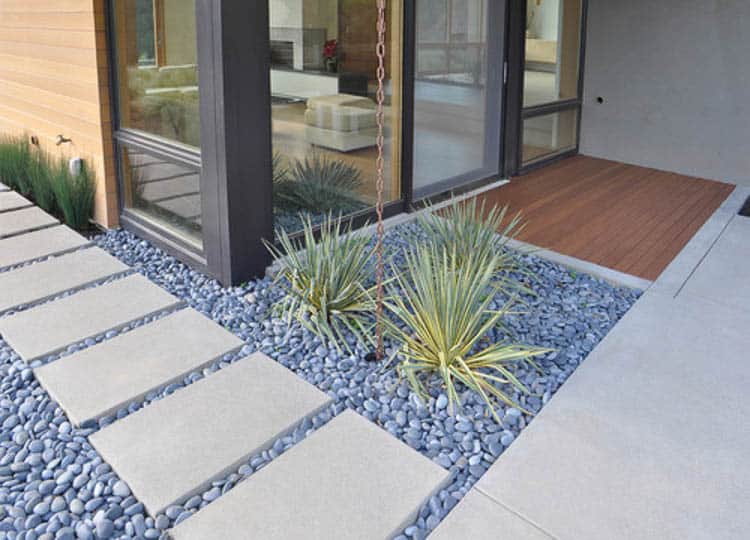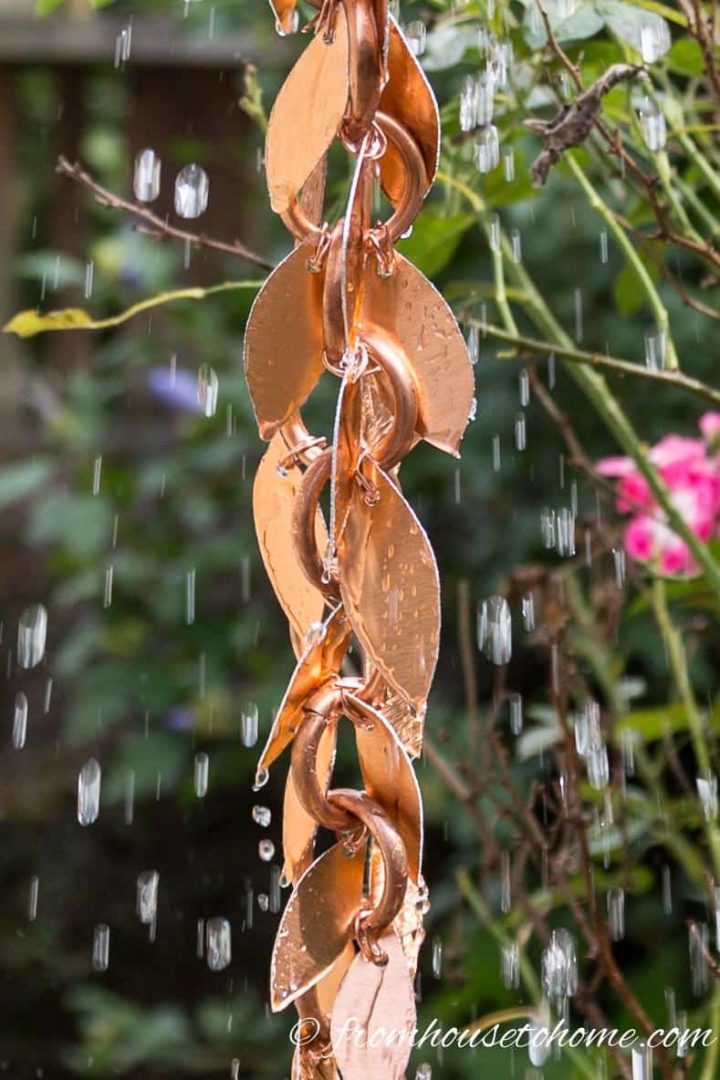Why Homeowners Are Ditching Downspouts for Stunning Rain Chains in Their Gardens
I'm sure you've seen those picturesque rain chains hanging in someone's garden, but do you ever wonder what the point of them is? Those chains are more than just decoration. They're a functional replacement for a downspout and we'll show you why so many homeowners are adding them to their gardens.
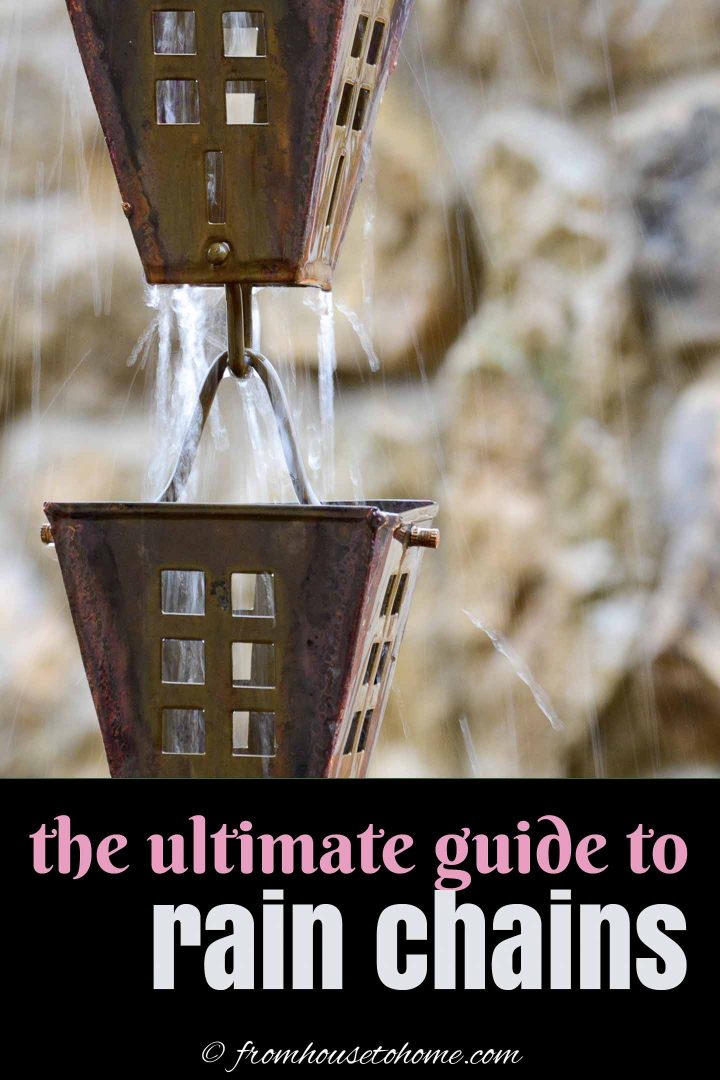
I actually don't remember where I first saw a rain chain, but I do remember that I fell in love with it the moment I saw it.
So now I have one at the front of my house and one at the back. And I'm plotting to get some more!
Although rain chains are becoming more popular, I still get a lot of people asking me what it is when they see it on my house.
So I thought I would write about my personal experience with them in case you have questions, too.
Note: Some of the images below are provided by houzz.com and cannot be pinned due to their copyright restrictions.
What is a rain chain?
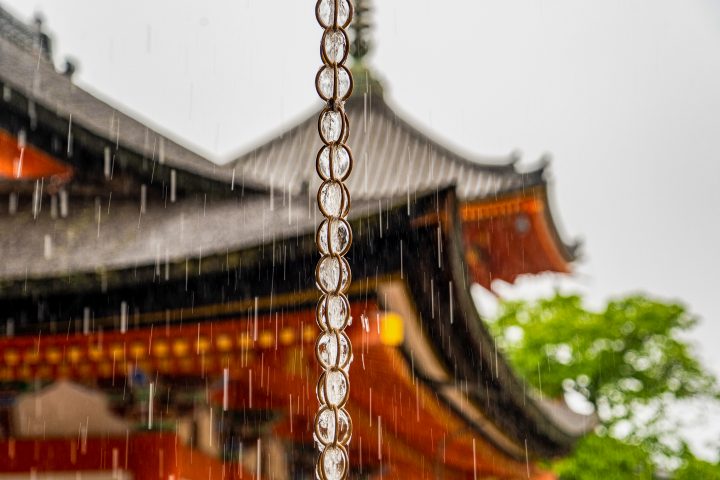
Rain chains originated in Japan (where they are known as Kusari-doi).
There, they have been used for hundreds of years to direct and collect the water from the roofs of buildings (like this Japanese temple).
And they continue to perform that same function in modern gardens today.
How do they work?
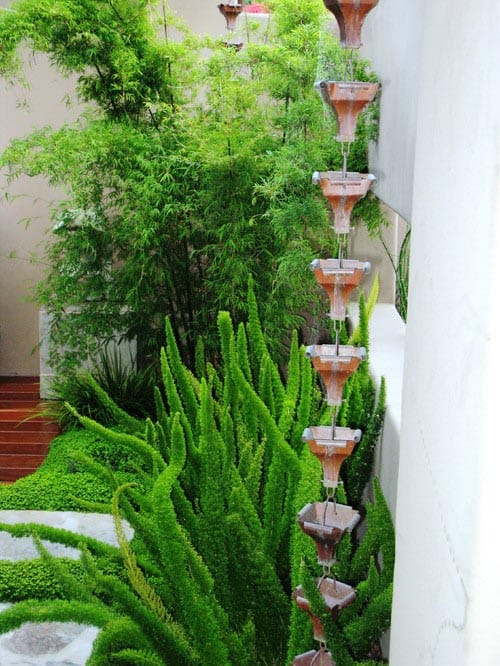
Rain chains are a functional alternative for the gutter downspouts on your house.
So you install them by removing the downspout and attaching the rain chain to the gutter where the downspout used to be.
Then when it rains, the rainwater flows off the roof into the gutter system and onto the chain.
The chain loops guide the water down into a drain, basin or barrel that either redirects or collects the runoff.
Why use a rain chain?
I think rain chains are so much more than just a replacement for a downspout.
And here's why.
1 | They are functional and decorative
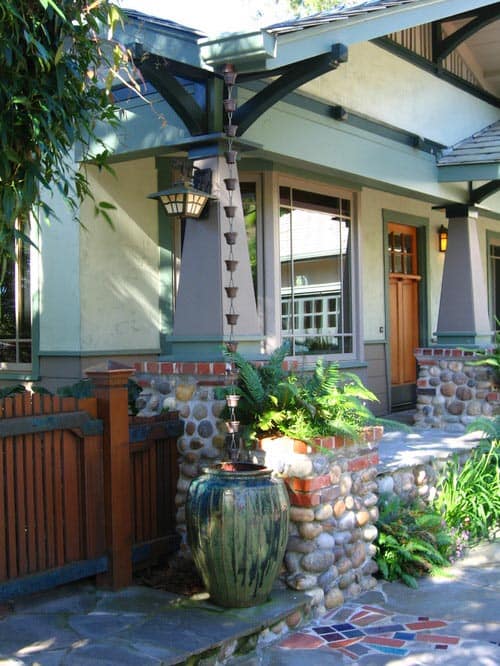
The first reason to hang a rain chain is that it looks so much better than a traditional gutter downspout. It adds some decoration to your house in addition to being functional.
And they are available in a lot of different styles and patinas so you can find one that suits the architecture of your house.
2 | They sound pretty when it rains
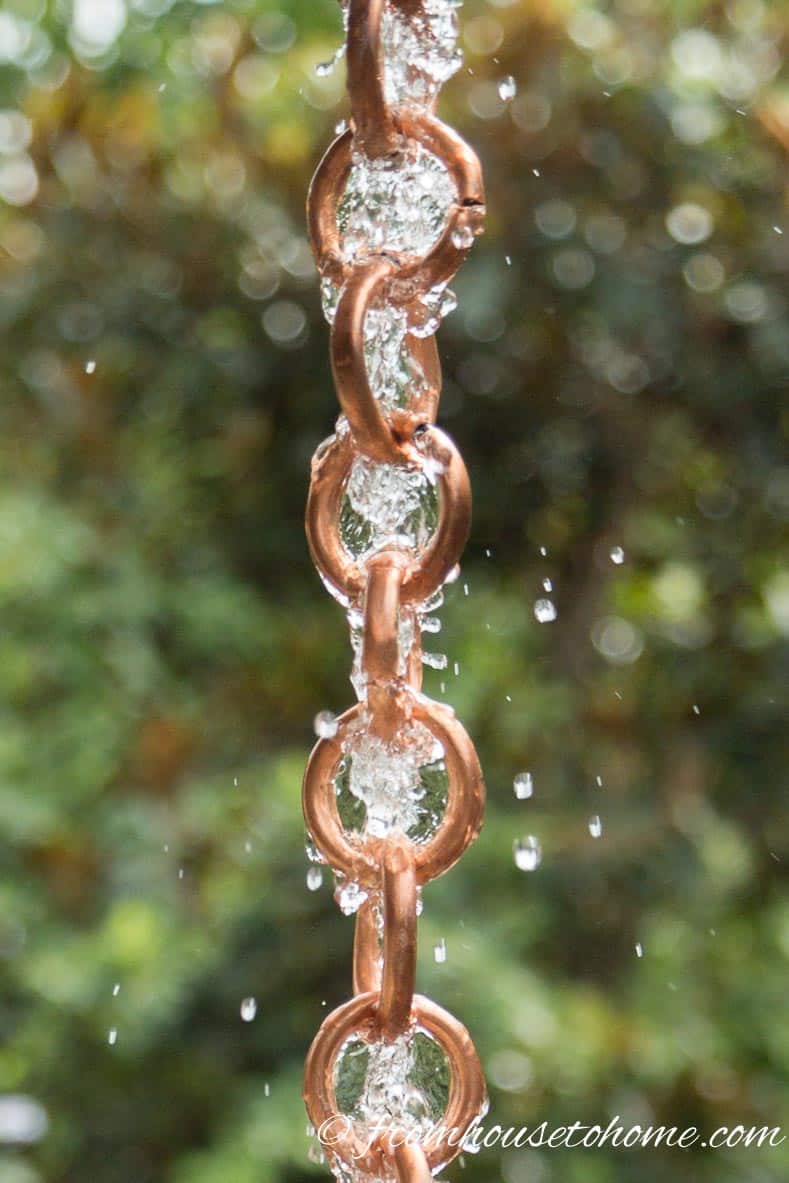
Second, rain chains sound really pretty when the water is flowing down them.
You never get that annoying dripping noise that sometimes happens with downspouts when the water hits the bottom of the spout.
3 | Rain chains are a low-maintenance water feature
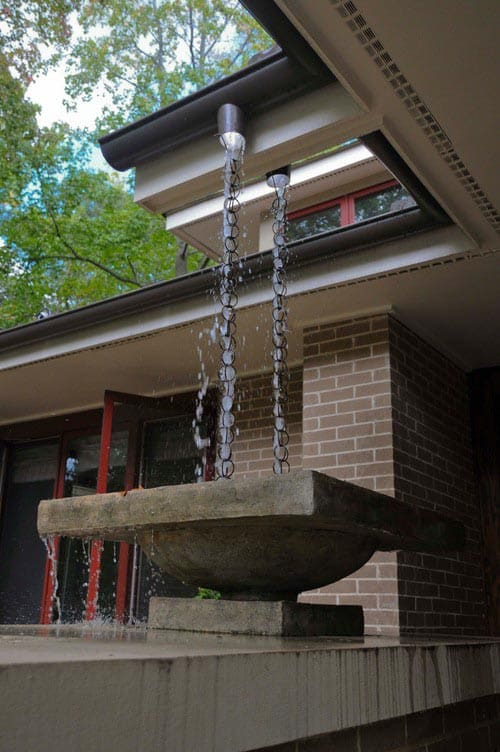
Third, you get a water feature in your garden that doesn't require any maintenance.
There's no pump to clean, no checking to make sure the water hasn't run down, and nothing to empty in the winter.
Now that's my kind of water feature!
4 | They turn into an ice sculpture
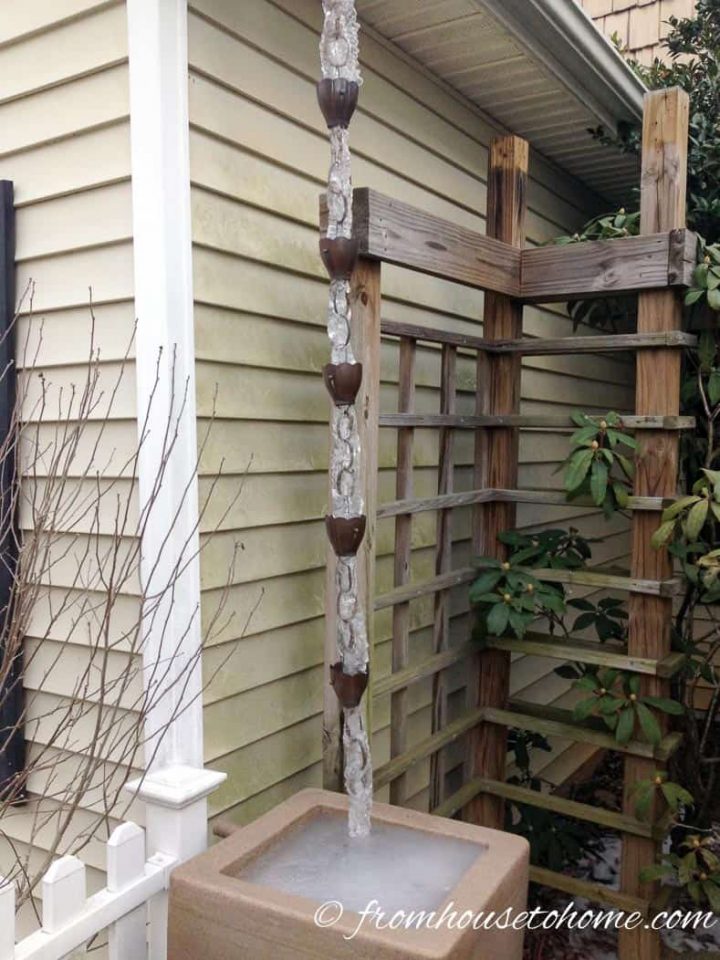
Fourth, rain chains even look nice in the winter.
We don't get too many icy, snowy winter days here in South Carolina, but it sure looks pretty when we do!
Should you take rain chains down in winter?
If you live in a colder climate that receives a lot of snow and ice, you may want to remove the rain chain for the winter.
The weight of the chain with the ice can cause damage to your gutters.
Do rain chains work in heavy rain?
When I installed my first rain chain, I wasn't sure if it would work as well as the downspout. Especially since we get some pretty heavy rainfalls in this part of the country.
Now that I have had it for a few years, I can say that rain chains work just as well as the downspout did, even when there's a heavy water flow.
Actually I would go one step further and say that it's better…I have a big tree in my front yard and the downspout always used to get clogged with tree leaves.
That never happens now. The leaves just fall through the hole to the ground.
What about high winds?
I also haven't had any problems with my rain chains in high winds. (And the weather we get that produces those heavy rain storms also tends to create some windy conditions).
I think they are close enough to the house that they are protected from the wind. Especially since I have some plants and bushes growing in those areas.
However, if you are worried about them getting blown around, you can attach the bottom of the chain to the basin or the ground with a hook.
What types of rain chains are there?
There are two main styles of rain chain: links and cups.
Link style rain chains
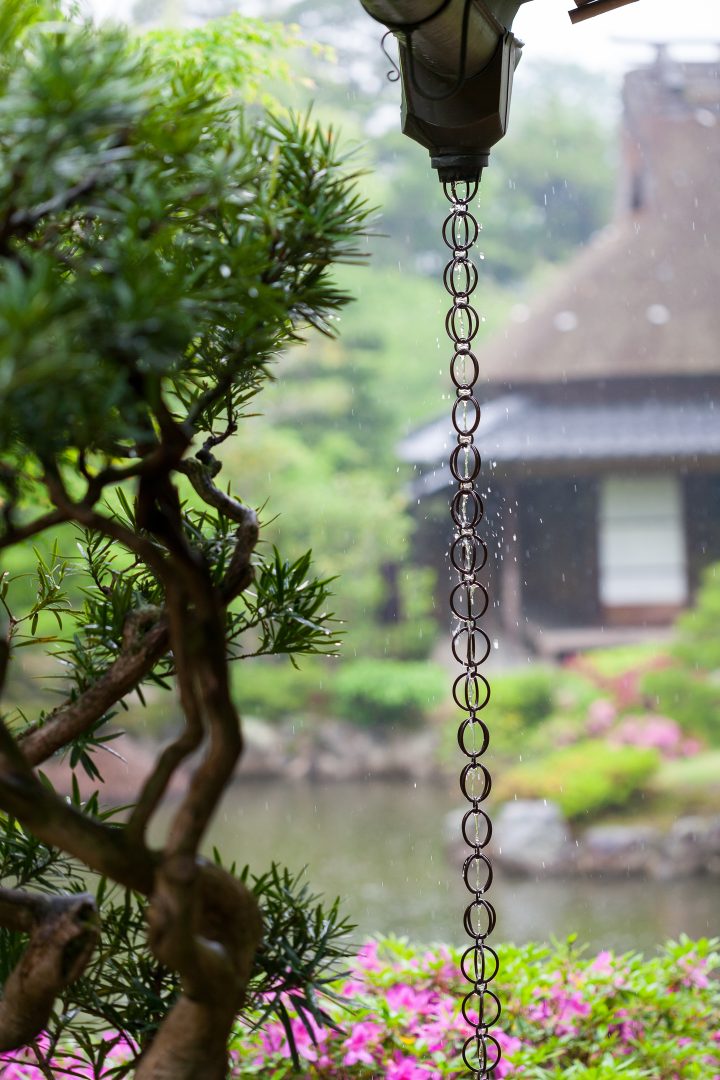
The simplest rain chains are literally just a chain that the water runs down like the one in this Japanese garden.
Cup style rain chains
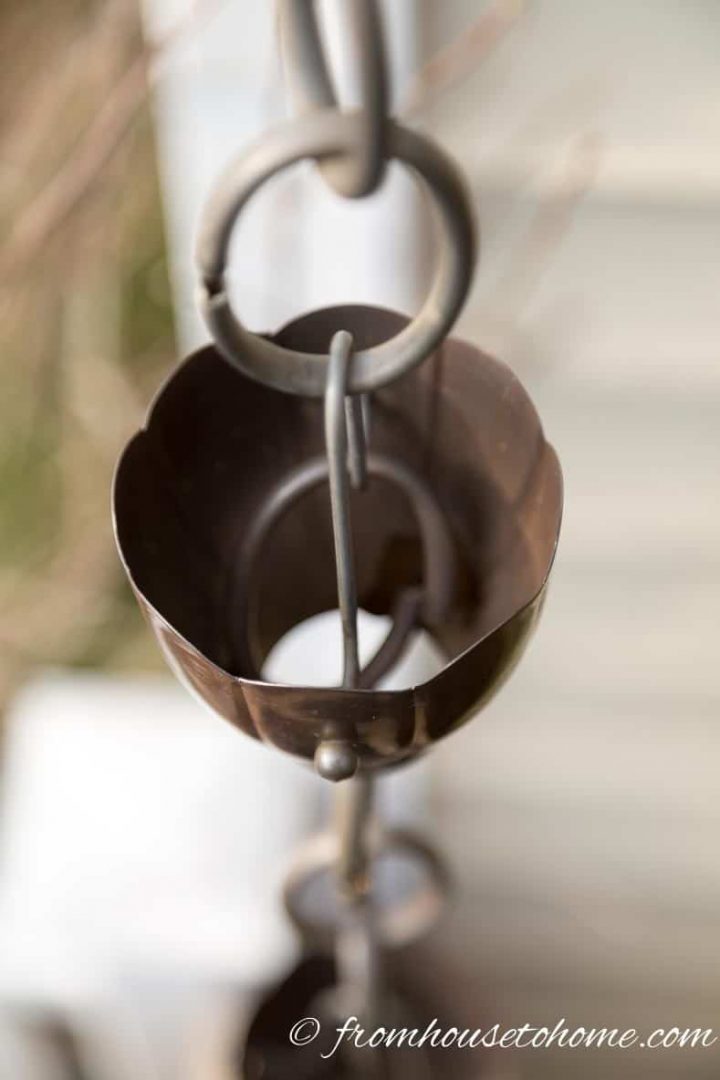
Slightly fancier versions have pails or cups with holes in the bottom that guide water down the chain.
These curved objects are suspended every 6 inches to a foot and catch the water as it flows down.
This slows down the water flow and causes pretty tinkling sounds.
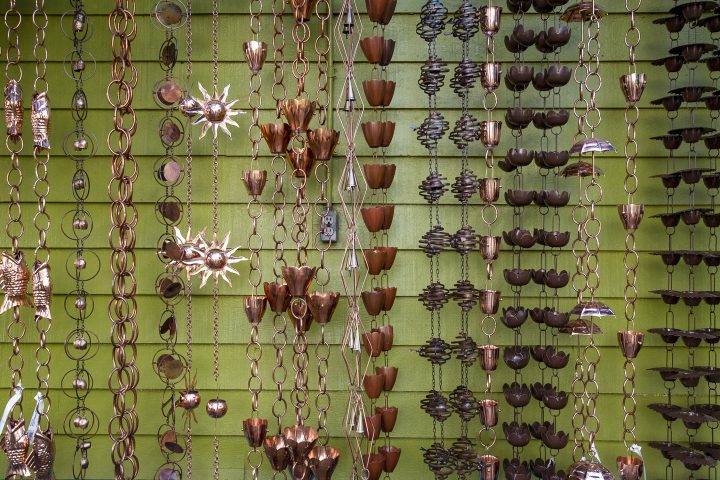
With their increase in popularity, cup style rain chains are now available in all kinds of shapes, colors and link styles.
So you should be able to find one that suits your design aesthetic.
What are rain chains made of?
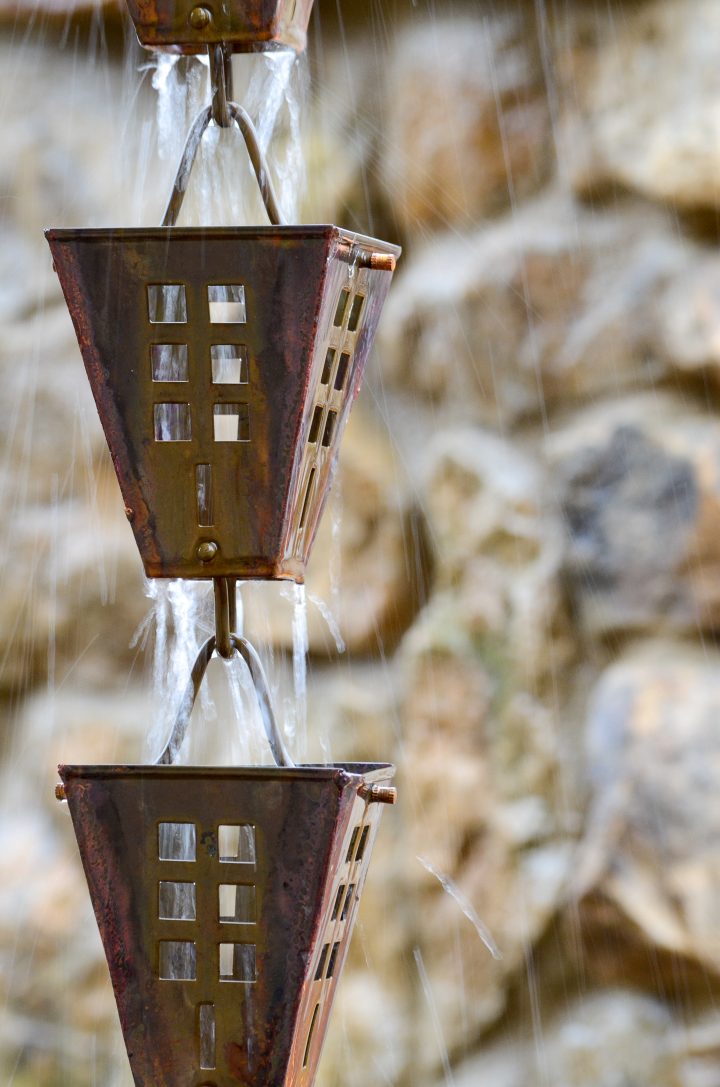
Traditional rain chains are made of pure copper, which turns into a beautiful tarnished green color as it ages.
However, they are also available in other metals such as stainless steel and aluminum (like this one*).
Since these metals doesn't rust or oxidize, the rain chain will always be this color.
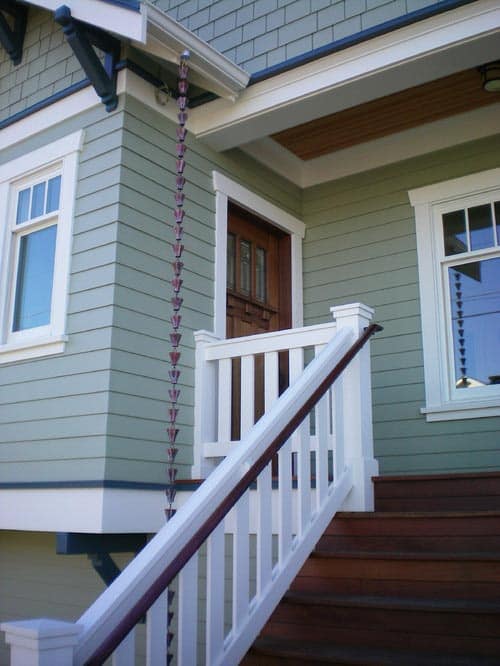
Or if you love color as much as I do, you can go for a powder-coated one like this fabulous purple version.
What do you put at the bottom of a rain chain?
Now you may be wondering what happens to the water when it gets to the bottom of the chain.
A basin, barrel or French drain is the best way to catch water runoff from a rain chain.
1 | Rain chain basin
A rain chain basin (like this one*) is a large bowl usually made out of cement or metal that catches the water at the bottom of the chain.
They often have a loop in the center where you can attach the end of the rain chain to prevent it from moving around too much.
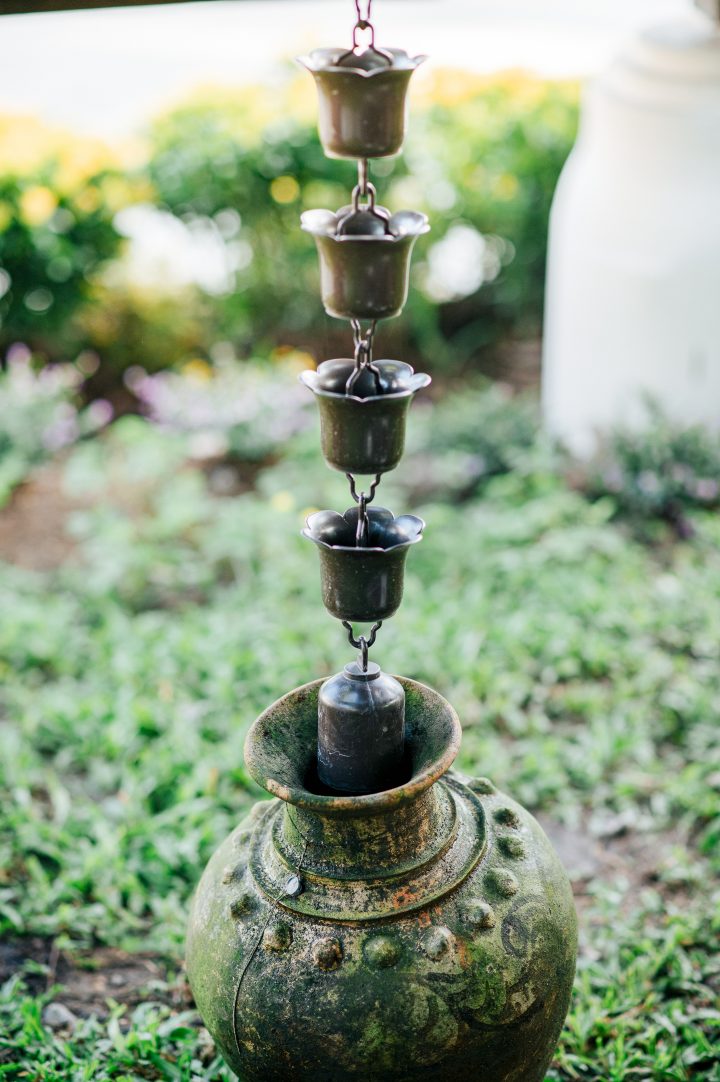
A ceramic or cement jar at the bottom of the chain can also be used to accomplish the same thing.
While these options look very pretty, they aren't always big enough to hold all of the water if you have a heavy rain storm.
So you'll need to make sure there is a way for the overflow to drain properly if you do get too much water.
And most ceramic jars will only work in areas that don't freeze in the winter.
2 | Rain barrel
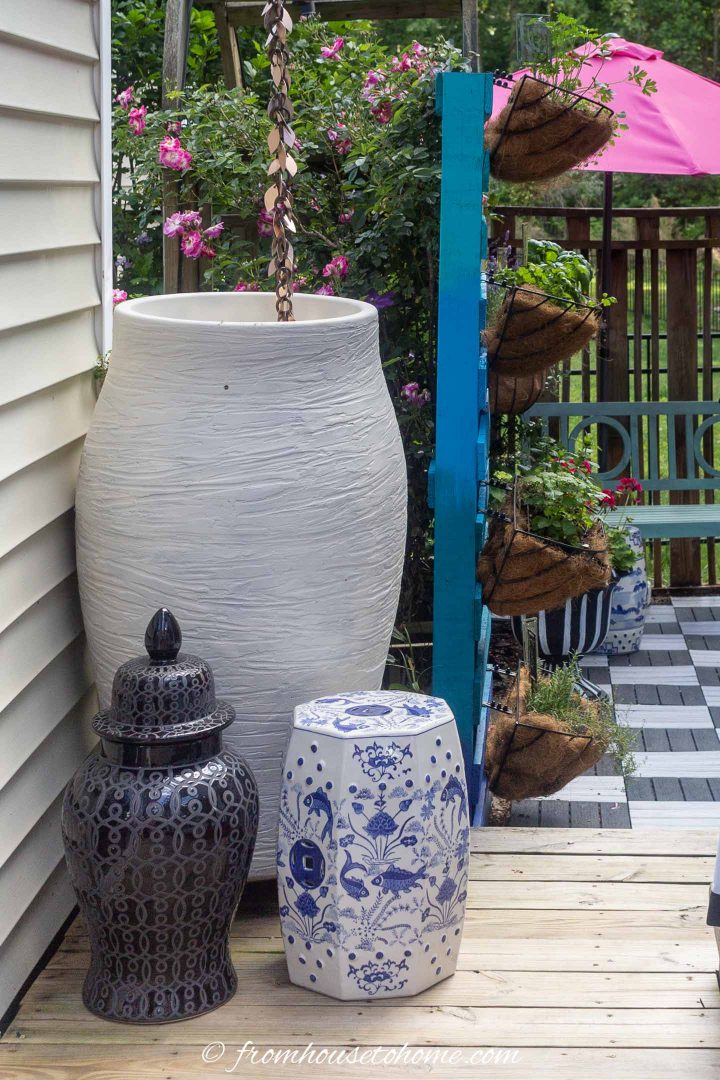
I use plastic rain barrels to catch the water runoff.
Rain barrels usually come with a faucet and hose attachment at the bottom of the barrel. That way the water can be used on the garden or just drained away from the house.
The ones I have look like large urns so they blend in with my outdoor decor (I did spray paint this one* off-white to make it match better).
3 | French drain
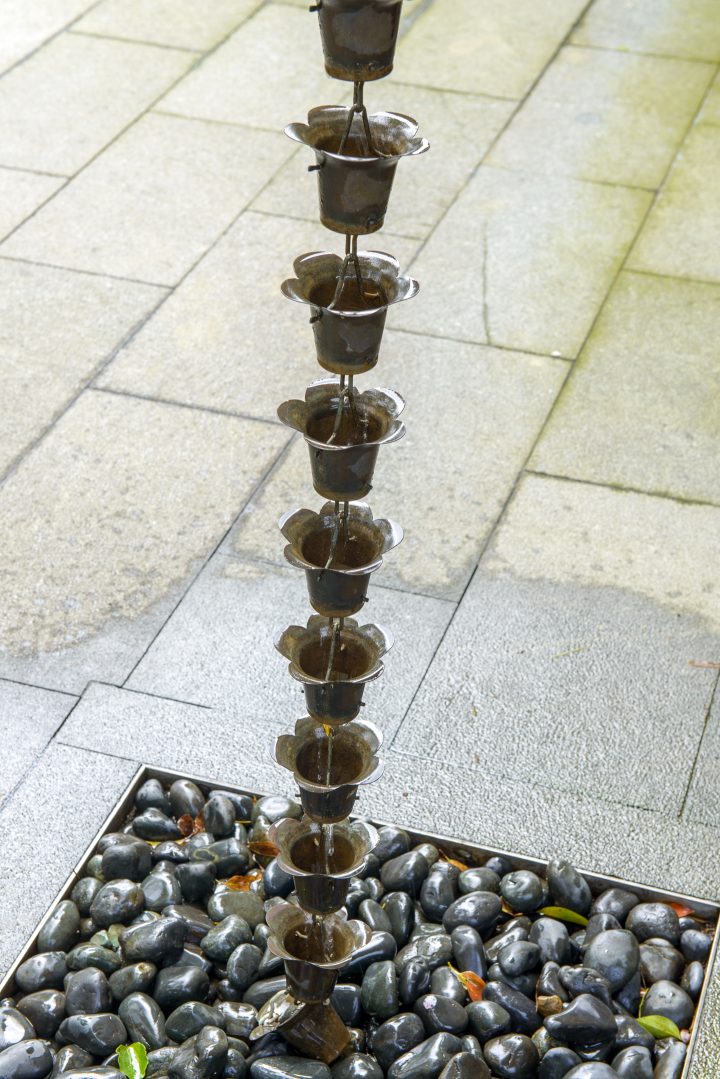
You can also build a large basin (or french drain) into the ground. This catches the water and lets it drain away from the house.
You will often see these covered in river rocks and pebbles so that they blend in with their surroundings.
If you are replacing a downspout that drains underground, you could leave the existing drain in place.
Then make sure that the rain chain is positioned above the drain pipe so that the water flows to the right spot. You may need to make a downward sloping funnel around the hole to catch any water that splashes outside of the hole.
Or anchor the bottom of the chain to the ground so that it doesn't have as much movement.
4 | Water feature
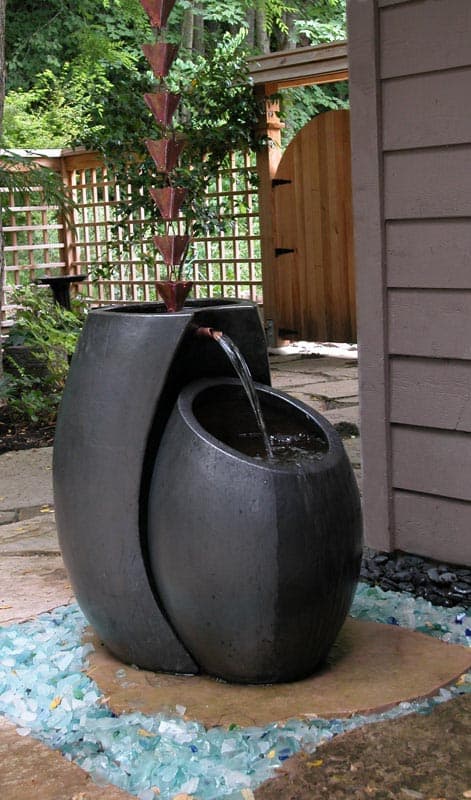
Finally, some people get really creative and make a whole decorative water feature out of the run off from their rain chain.
Rain chain installation
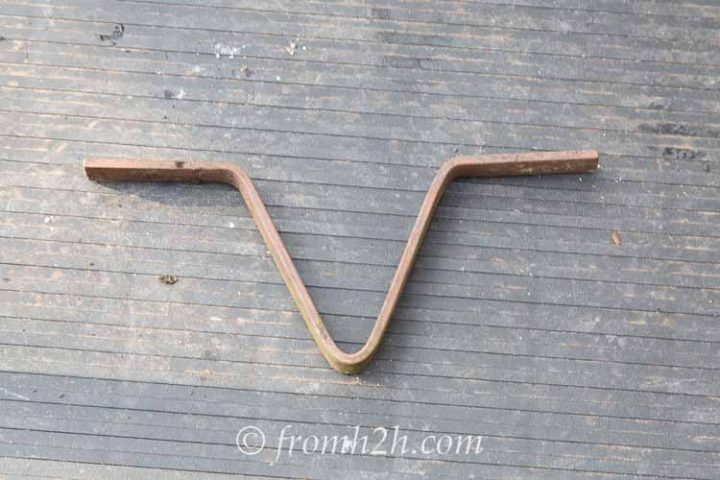
Rain chains are actually very easy to install.
The first setup step is to disconnect the down spout. Undoing the screws that are holding the down spout in place is probably the hardest part of the job.
Most come with a bracket that looks like a V with tails.
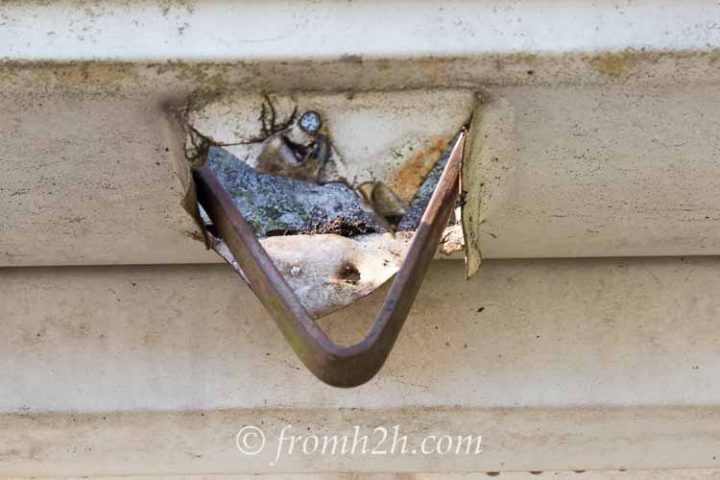
Place this bracket into the eave trough with the V coming down through the hole where the downspout used to be. (Sorry for the dirty eaves…I haven't done the spring clean up yet!)
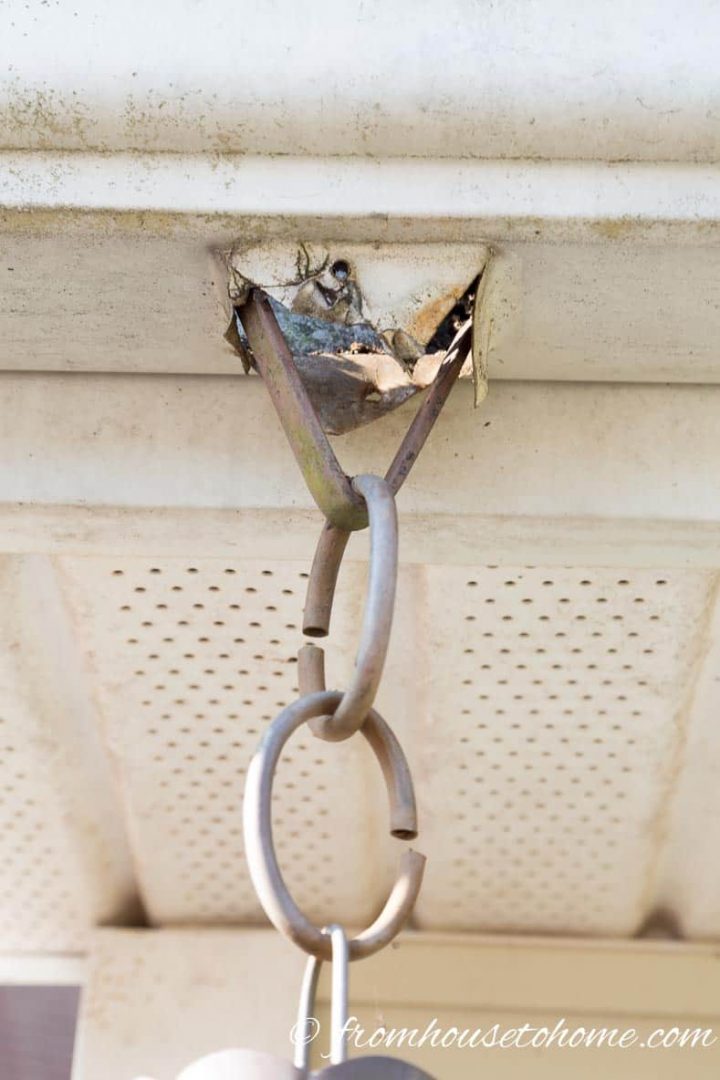
Hook the first rung of the chain to the V portion of the bracket. You're done!
For more details or to learn how to use a rain chain installation kit, read how to install a rain chain.
Where to buy one?
Rain chains are available for purchase in many garden centers and nurseries.
However they are becoming so popular that you can buy them in lots of places online:
- Amazon has hundreds of styles you can choose from (check them out HERE*).
- You can find them at Home Depot (HERE)*.
- Even Walmart carries a decent selection (HERE)!
Can you make a rain chain?
If you don't want to spend much money on buying one, I have heard of people using standard steel chain (although I'm not sure it would have the same visual appeal).
Or if you don't mind a DIY project, you can learn how to make a rain chain.
Well, that's my guide of everything you need to know to add these beautiful drainage replacements to your garden. Hopefully you have found some rain chain inspiration for your own yard!
Other garden features you might like
- How to make a simple DIY copper link rain chain
- DIY leaf rain chain
- How to install a rain chain
- Ways to add water to your garden
- Garden art ideas for your yard
Have comments or questions on rain chains? Tell us in the section below.
Pin It So You Don't Forget It!
